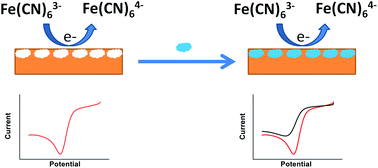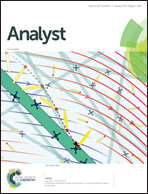A kanamycin sensor based on an electrosynthesized molecularly imprinted poly-o-phenylenediamine film on a single-walled carbon nanohorn modified glassy carbon electrode†
Abstract
A single-walled carbon nanohorn (SWCNH) has been used to construct a molecularly imprinted electrochemical sensor for the first time. Kanamycin, a widely used aminoglycoside antibiotic, is used as a representative analyte to test the detection strategy. The kanamycin sensor was constructed by the electropolymerization of a molecularly imprinted poly-o-phenylenediamine film on a SWCNH modified glassy carbon electrode. The sensor was investigated in the presence or absence of kanamycin by cyclic voltammetry to verify the changes in the redox peak currents of K3Fe(CN)6. The sensor exhibits a linear range of 0.1–50 μM with a detection limit of 0.1 μM. It also shows high recognition ability, indicating that the SWCNH-based molecularly imprinted sensor is promising.

- This article is part of the themed collection: In memory of Craig Lunte

 Please wait while we load your content...
Please wait while we load your content...